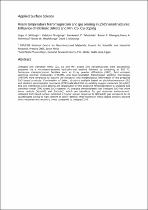 ResearchSpace
ResearchSpace
Room temperature ferromagnetism and gas sensing in ZnOnanostructures: Influence of intrinsic defects and Mn, Co, Cu doping
JavaScript is disabled for your browser. Some features of this site may not work without it.
- ResearchSpace
- →
- Research Publications/Outputs
- →
- Journal Articles
- →
- View Item
| dc.contributor.author |
Mhlongo, Gugu H

|
|
| dc.contributor.author |
Shingange, Katekani

|
|
| dc.contributor.author |
Tshabalala, Zamaswazi P

|
|
| dc.contributor.author |
Dhonge, Baban, P

|
|
| dc.contributor.author |
Mahmoud, FA

|
|
| dc.contributor.author |
Mwakikunga, Bonex W

|
|
| dc.contributor.author |
Motaung, David E

|
|
| dc.date.accessioned | 2017-08-31T07:14:05Z | |
| dc.date.available | 2017-08-31T07:14:05Z | |
| dc.date.issued | 2016-12 | |
| dc.identifier.citation | Mhlongo, G.H., Shingange, K., Tshabalala, Z.P., Dhonge, B.P., Mahmoud, F.A., Mwakikunga, B.W. and Motaung, D.E. 2016. Room temperature ferromagnetism and gas sensing in ZnOnanostructures: Influence of intrinsic defects and Mn, Co, Cu doping. Applied Surface Science, 390, pp 804–815 | en_US |
| dc.identifier.issn | 0169-4332 | |
| dc.identifier.uri | http://www.sciencedirect.com/science/article/pii/S0169433216317949 | |
| dc.identifier.uri | http://hdl.handle.net/10204/9511 | |
| dc.description | Copyright: 2016 Elsevier. Due to copyright restrictions, the attached PDF file only contains the abstract of the full text item. For access to the full text item, please consult the publisher's website. The definitive version of the work is published in Applied Surface Science, 390, pp 804–815 | en_US |
| dc.description.abstract | Undoped and transition metal (Cu, Co and Mn) doped ZnO nanostructures were successfully prepared via a microwave-assisted hydrothermal method followed by annealing at 500 °C. Numerous characterization facilities such as X-ray powder diffraction (XRD), field emission scanning electron microscopy (FESEM), and high-resolution transmission electron microscopy (HRTEM) were employed to acquire the structural and morphological information of the prepared ZnO based products. Combination of defect structure analysis based on photoluminescence (PL) and electron paramagnetic resonance (EPR) indicated that co-existing oxygen vacancies (V(subO)) and zinc interstitials (Zni) defects are responsible for the observed ferromagnetism in undoped and transition metal (TM) doped ZnO systems. PL analysis demonstrated that undoped ZnO has more donor defects (V(subO) and Zn(subi)) which are beneficial for gas response enhancement. Undoped ZnO based sensor exhibited a higher sensor response to NH(sub3) gas compared to its counterparts owing to high content of donor defects while transition metal doped sensors showed short response and recovery times compared to undoped ZnO. | en_US |
| dc.language.iso | en | en_US |
| dc.publisher | Elsevier | en_US |
| dc.relation.ispartofseries | Workflow;18066 | |
| dc.subject | Ferromagnetism | en_US |
| dc.subject | Defects | en_US |
| dc.subject | ZnO | en_US |
| dc.subject | Sensing properties | en_US |
| dc.title | Room temperature ferromagnetism and gas sensing in ZnOnanostructures: Influence of intrinsic defects and Mn, Co, Cu doping | en_US |
| dc.type | Article | en_US |
| dc.identifier.apacitation | Mhlongo, G. H., Shingange, K., Tshabalala, Z. P., Dhonge, B., Mahmoud, F., Mwakikunga, B. W., & Motaung, D. E. (2016). Room temperature ferromagnetism and gas sensing in ZnOnanostructures: Influence of intrinsic defects and Mn, Co, Cu doping. http://hdl.handle.net/10204/9511 | en_ZA |
| dc.identifier.chicagocitation | Mhlongo, Gugu H, Katekani Shingange, Zamaswazi P Tshabalala, Baban Dhonge, FA Mahmoud, Bonex W Mwakikunga, and David E Motaung "Room temperature ferromagnetism and gas sensing in ZnOnanostructures: Influence of intrinsic defects and Mn, Co, Cu doping." (2016) http://hdl.handle.net/10204/9511 | en_ZA |
| dc.identifier.vancouvercitation | Mhlongo GH, Shingange K, Tshabalala ZP, Dhonge B, Mahmoud F, Mwakikunga BW, et al. Room temperature ferromagnetism and gas sensing in ZnOnanostructures: Influence of intrinsic defects and Mn, Co, Cu doping. 2016; http://hdl.handle.net/10204/9511. | en_ZA |
| dc.identifier.ris | TY - Article AU - Mhlongo, Gugu H AU - Shingange, Katekani AU - Tshabalala, Zamaswazi P AU - Dhonge, Baban, P AU - Mahmoud, FA AU - Mwakikunga, Bonex W AU - Motaung, David E AB - Undoped and transition metal (Cu, Co and Mn) doped ZnO nanostructures were successfully prepared via a microwave-assisted hydrothermal method followed by annealing at 500 °C. Numerous characterization facilities such as X-ray powder diffraction (XRD), field emission scanning electron microscopy (FESEM), and high-resolution transmission electron microscopy (HRTEM) were employed to acquire the structural and morphological information of the prepared ZnO based products. Combination of defect structure analysis based on photoluminescence (PL) and electron paramagnetic resonance (EPR) indicated that co-existing oxygen vacancies (V(subO)) and zinc interstitials (Zni) defects are responsible for the observed ferromagnetism in undoped and transition metal (TM) doped ZnO systems. PL analysis demonstrated that undoped ZnO has more donor defects (V(subO) and Zn(subi)) which are beneficial for gas response enhancement. Undoped ZnO based sensor exhibited a higher sensor response to NH(sub3) gas compared to its counterparts owing to high content of donor defects while transition metal doped sensors showed short response and recovery times compared to undoped ZnO. DA - 2016-12 DB - ResearchSpace DP - CSIR KW - Ferromagnetism KW - Defects KW - ZnO KW - Sensing properties LK - https://researchspace.csir.co.za PY - 2016 SM - 0169-4332 T1 - Room temperature ferromagnetism and gas sensing in ZnOnanostructures: Influence of intrinsic defects and Mn, Co, Cu doping TI - Room temperature ferromagnetism and gas sensing in ZnOnanostructures: Influence of intrinsic defects and Mn, Co, Cu doping UR - http://hdl.handle.net/10204/9511 ER - | en_ZA |





